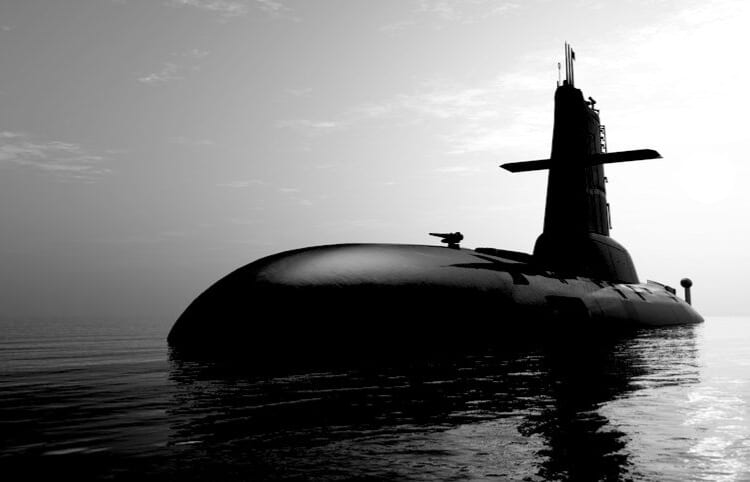MARIA Eagle, a defence minister, has declined to reveal patrol lengths of the nuclear deterrent submarines (SSBNs). She said: ‘We do not disclose details of the operation, including the duration of time spent at sea, as such information could be used to undermine the security and capability of the mission and our personnel.’ Which is, in fact, not entirely true.
On March 19 the Prime Minister and Defence Secretary John Healey made a public visit to meet the crew of HMS Vanguard after their record 204 days at sea. This information and photo op was released to the press. As ever with this government, it’s one rule for Two-Tier and one for everyone else.
It’s no secret that the Royal Navy has maintenance infrastructure problems. The submarine lift in Faslane broke last year although it is now thought to be working. There have also been problems in the only other suitable dock in Devonport, although these too are thought to have been fixed, according to the usually very well-informed Navy Lookout. If submarines are awaiting maintenance they can’t go to sea, so the serviceable ones work harder and must stay at sea longer.
While everything about nuclear weapons and the nuclear submarines that carry them is highly classified this should not be carte blanche for covering up Ministry of Defence failures. A submarine having to spend 204 days at sea is a huge logistic and psychological challenge. The Vanguard class SSBNs were originally equipped with freezers to store three or four months’ food for the crew of 135. Unlike other warships, the UK’s SSBN fleet never replenish at sea because if they surfaced they would give away their position, rendering them vulnerable and the UK’s independent deterrent at risk. Stretching the patrol length by over 50 per cent requires space to be found for more than 24,000 extra meals.
The Vanguard class boats (in Royal Navy parlance submarines are referred to as boats, despite being warships and bigger than a frigate) are older than their 25-year design life, so maintenance is crucial and complex. The £560million deep maintenance for another SSBN, Victorious, is planned to take three years. Similar maintenance on Vanguard took seven years. With only three SSBNs available the minimum patrol length is four months – longer if any complex maintenance or repairs are needed. This high pressure is likely to continue until the replacement Dreadnought class come into service in the early 2030s.
Why is the independent deterrent in such an appalling mess? Politicians kicking the can down the road. Bizarrely, when Tony Blair committed to renewing the Trident missiles in 2006 it was decided to delay ordering the submarines to carry them as a cost-saving exercise. Like all such delays, at almost £600million per boat for deep maintenance keeping the four Vanguard class SSBNs operating has cost at least £2.5billion. Some saving! The Dreadnoughts were eventually ordered in 2016, the first keel being laid down in Barrow last week.
That almost entirely political delay explains why the Vanguards are having to serve for so long. The maintenance failures are attributable to the broken (30-year-old) lift and waiting for the £750million upgrade of a dry dock in Devonport to complete, scheduled for 2027. As an aside, Devonport dockyard is owned by Babcock, a defence company, not the Royal Navy. The responsibility for submarine procurement, maintenance and disposal lies with the Submarine Delivery Agency (SDA). It was set up in 2018 when Gavin Williamson was the Secretary of State for Defence. So far it’s not doing very well.
For enthusiasts of wasteful government spending, the original contract for the Vanguards envisaged building two dry docks for their maintenance in Rosyth. That would have allowed for one to be in deep maintenance or upgrade, keeping the second dry dock available for repairs and routine maintenance. All eminently sensible. Unfortunately the Options for Change defence cuts of the 1990s stopped the work in Rosyth after £120million had been spent. Rather than support the SSBNs where they were based the task was moved to Devonport, with only one dry dock. Thirty years later that is finally being rectified.
This is the nuclear deterrent – the single most important part of the UK’s defence policy. Yet under the cloak of secrecy (a failing public servant’s best friend) this has been hidden from scrutiny by successive governments. The question to Maria Eagle was asked by the chair of the Defence Select Committee, Tanmanjeet Singh Dhesi MP. Select committees are supposedly there to hold the government machine to account in a way that Parliament can’t. Yet the MoD and their parliamentary mouthpiece treated the chairman’s entirely reasonable question with obfuscation and contempt.
If the government machine can’t run the nation’s highest priority capabilities, what can it do? If Parliament can’t get sensible answers to reasonable questions, what’s the point of it? The whole system is a festering pile of ineptitude, incompetence and waste. The disgraceful mismanagement of SSBN maintenance occurred in governments of all political parties. Who pays the price? The taxpayer plus not-so-jolly Jack and Jenny Tar and their families.
What can be done about it? Change the system, which mean Reform need to figure out how to win a majority and ensure that their candidates have the ability to hold the Blob to account. That means they need to have considerable experience outside of SW1. They will also need to develop policies, outline the necessary legislation and communicate that to an exasperated public long before the next election.











